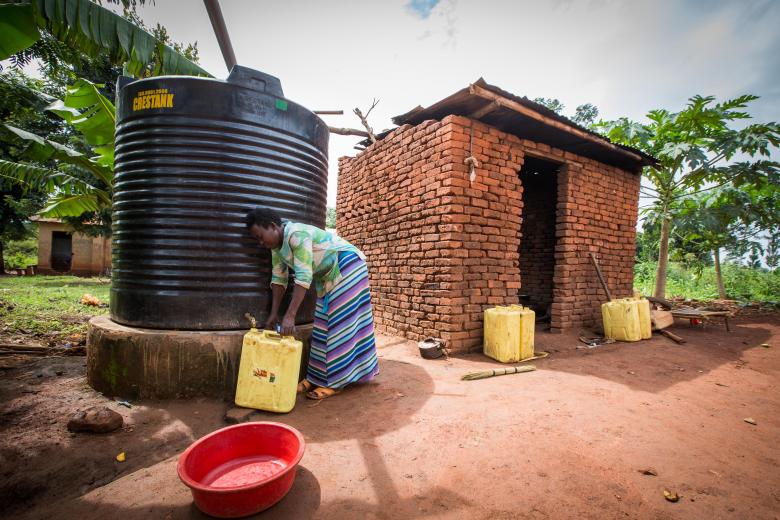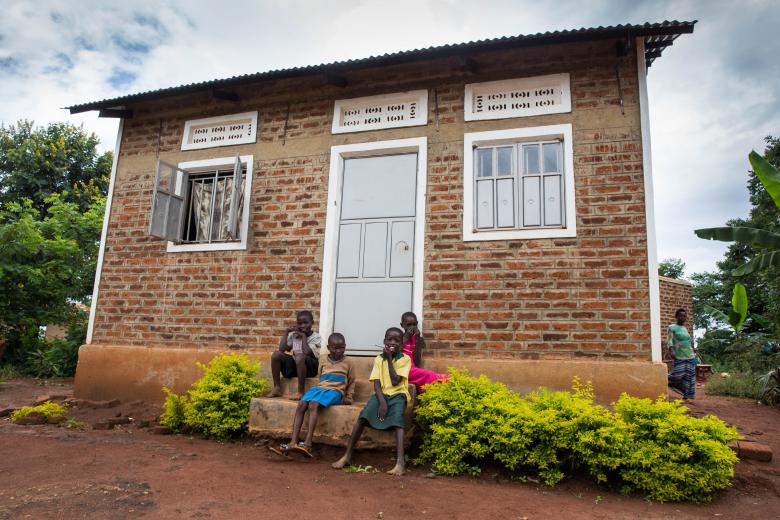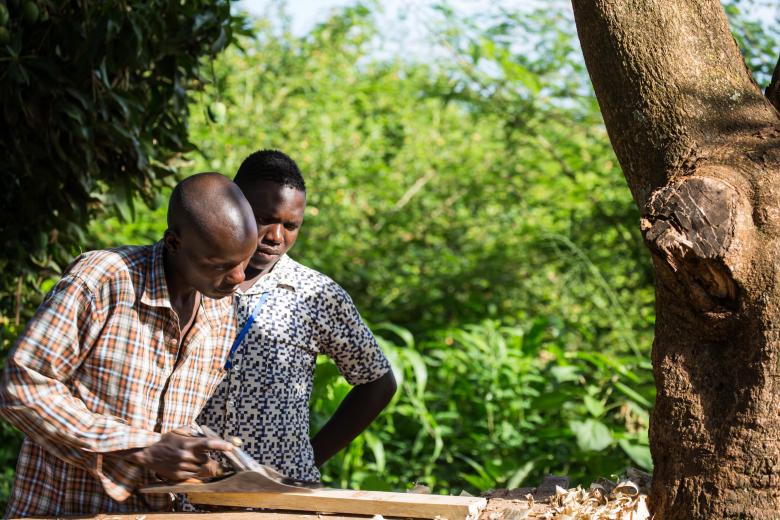More than just a house
Building self-reliance and stability in Uganda
“Things began to go wrong for us, when our father died,” says twenty-one year-old Job Kalulu.
Job was still in primary school when his father’s died. It wasn’t long before in-laws made a grab for the large family house, and drove out Job, his mother, and nine siblings from their home.
His mother escaped being married off to someone else in the family (a custom practiced by some in Job’s Basoga tribe) but she and the family didn’t escape the abject poverty that followed.
The family fled to the nearby village of Bugoya in the Mayuge District, a three-hour drive east of Kampala. Their maternal uncle offered them shelter in a single-room structure he used as an outdoor kitchen and for his goats and chickens. When it rained, the leaking grass-thatched roof forced the family to sleep under the bed with the chickens.

“The whole family was also at the mercy of fleas and jiggers,” Job remembers. “At school other students made fun of us because of our jigger-infested feet.” Jiggers, known as chigoe fleas, burrow into the exposed skin of human feet to breed, causing swelling, blisters and intense irritation.
And, eventually, Job had to drop out of school. The family couldn’t afford the school fees.
Today, Job’s cheerful face and deep respect for people belie the hardships that he, his siblings, and mother had to endure.
“Our future changed when my mum heard about Habitat for Humanity at a church meeting,” Job said.
Habitat for Humanity Uganda runs a program for orphans and children and their caregivers made vulnerable by war, disability, or disease. Running in the Mayuge and Kumi districts in eastern Uganda and Kiryandongo in western Uganda, the program provides a decent place to live along with support and vocational training.
The Habitat Uganda homes come complete with a rain water harvesting and storage system, and a ventilated improved pit-latrine (VIP) attached to a shower stall.
Since 1982, Habitat Uganda has built, rehabilitated, repaired or improved more than 8,100 homes providing shelter for more than 60,000 people in 20 districts.
Job’s family applied and was selected in 2012 with construction starting almost immediately because they owned the land.
“We first resolved any land issues that may affect the family,” said Charles Waiswa, Habitat Uganda Mayuge project officer. “Then we provided assistance in willwriting, mainly to ensure security of ownership for the children.
“We also trained them on how to keep memory books of their family. The memory book of pictures, stories and feelings provides a powerful, enduring statement of the strengths of the family.”
While their new home was under construction, Job’s family also received training on how to take care of it. In 2013 they moved from their one-room shack into their new four-room home.
“We were very happy and excited,” Job stated. “We could not believe that we were finally moving. To celebrate we prepared chicken and rice and borrowed a radiocassette from a neighbor. We ate and danced through the night. We had never stayed in a cemented house before.”
“We no longer have to worry about the rain either,” remembering the nights he spent under the bed in their old shack. “The rain fills the tank and makes our life better.”

Habitat Uganda’s vocational training program is a crucial component in the success of its work. One family member is taught a trade to help ensure the family’s economic sustainability. In Job’s case, he was selected and trained as a carpenter.
“I earn enough money to help mum pay school fees, and buy books and uniforms for my six siblings,” he says. In a good month, Job earns as much as US$50 from making beds, stools and coffee tables. That goes a long way in paying the US$90 tuition for three semesters.
Job has also earned his fellow villagers’ trust and respect in a number of ways.
“They come to me because I work professionally and deliver on time. And, my rates are affordable,” he stated.
We could not believe that we were finally moving. We ate and danced through the night. We had never stayed in a cemented house before.— Job
Job is also willing to share his skills. He is teaching six of his friends in the village simple carpentry skills. As he watched 20-year old Makoma Wamuzi plane wood by hand, he said “I want them to succeed and live better. This would be a boost for our village.”
With the help of his uncle, Job’s family has recently installed solar panels to light the home when it gets dark. The children can now study longer. And, Job’s mother says “It’s better and safer for the children. And we no longer have to worry about buying as much kerosene for the lamp.”
Solar power also gives Job more flexibility in his work. “I can work from morning until six in the evening, take a break to wash up and have dinner, and then go back to my work bench under the lights.”
Job isn’t quite ready to stop thinking about his future. “I want to learn more, so I can start making sofa sets and other furniture,” he said. “I also want to start carpentry workshops in neighboring villages.”

Since 1982, Habitat Uganda has built, rehabilitated, repaired or improved more than 8,100 homes providing shelter for more than 60,000 people in 20 districts.
“It is not so much about giving a house,” said Brent Potts, National Director, Habitat for Humanity Uganda. “It is seeing the release of productive energy and hope in the beneficiaries for a better tomorrow. Job can now go about his business and put his energy to productive use.”
Brent is working on a new plan to scale up Habitat Uganda’s activities and source funding to shelter up to 150,000 families living in poorest rural areas by 2020. Brent believes such a move can keep communities together. “People tend to move to major urban centers like Kampala, in search of better life, but end up in slums.
“We need to do this now because the need for shelter in Uganda is overwhelming” said Brent. “About 6.82 million households live in 6.2 million housing units, with an average household size of six persons and the housing deficit is growing by hundreds of thousands of units per year.”
Learn more about Habitat for Humanity’s work in Uganda.
